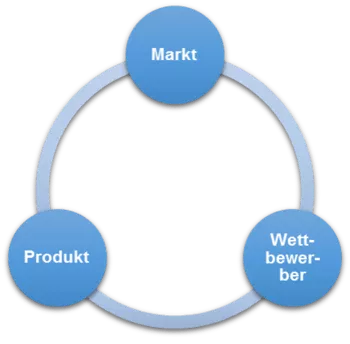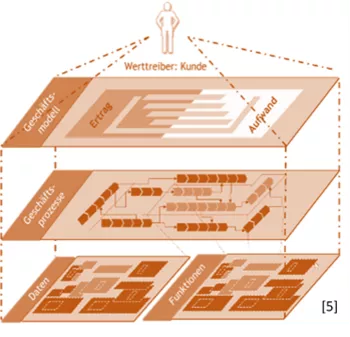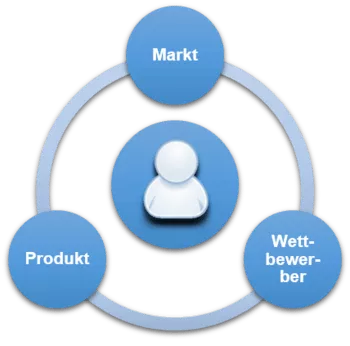The role of the customer
The central role of the customer for the strategic alignment of businesses has been discussed in science for decades.
"It costs much more to acquire a customer than it does to keep a customer. That is why a sale to a customer is good, but a relationship with a customer is great." [1]
"Personal data are the fuel of the modern economy" [2]
"In a global information-based economy, data about customers are one of the most important sources for competitive advantage." [3]
Nowadays, the customer's role is of even greater importance, in particular for businesses operating in highly competitive industries with a large number of end customers.
You are welcome to watch our webinar on our YouTube channel which also illustrates the topic by means of practical examples with SAP!
Historically, many business models have been aligned according to the market, the product or the competitors.
In this context, central questions were
- Do you operate on a niche or a mass market?
- How is your position compared to the competitors?
- How are you able to optimize your product portfolio?
If at all, the customer has been integrated in the process at a later point. Accordingly, the customer requirements were neglected for the most part in the management of many businesses.
Currently, businesses are facing new challenges. They operate in a very dynamic environment which is characterized by both the constant technical progress and the intensive data exchange. The boundaries between businesses, suppliers and customers become increasingly blurred. Market shares are fiercely contested due to ever increasing competition, which negatively affects the profitability. Businesses which interact with many individual customers are moreover confronted with high costs which are caused by inconsistent and incorrect customer data. These affect the whole business as multiplier - from the implementation of marketing campaigns to services up to incorrect forecasting and management.
Challenges in creating a unified customer profile
According to the 2015 Experian Digital Marketing Survey [4], 89% of the interviewed businesses have problems creating a consistent customer profile. Bad data quality was named as the main reason (43%) for this. By contrast, the effective and business-wide application integration is the greatest challenge in implementing a cross-channel marketing strategy for nearly one-third of the respondents (32%). In addition, this also fails due to the organizational structure (31%) and because uniform and customer-centred processes and KPIs are not established, across the entire enterprise.
In some cases, acceptance problems among the decision makers or even the intentional lack of transparency with regard to the team or the management level may cause problems regarding the campaign implementation. This is particularly the case if industries were privatised and thus were subjected to an unfamiliarly high competitive pressure. By complying with established processes and management models, the objectives defined by management are missed more and more often.
The target: the customer in the center
In order to successfully fight against this, businesses need to focus the strategic alignment on the customers. First of all, the own processes should be analysed and optimized by means of integrating a strong customer focus. However, this requires the merging of all customer-centred data and information into a holistic view on the customer, "across departments and above all application boundaries" [5].
In addition, maintenance and cleansing processes for all data need to be created. Even if the implementation is done once, these processes need to be implemented on a regular basis in order to ensure data stringency and consistency in the future, as well.
In addition, the "functionalities of the operation realized via information technology must be adjusted to the customer-centred processes and linked across the applications". [6]
Meeting the needs of customers - with b.telligent
By creating a standardized customer profile for each individual customer, the fast, individual and adequate response to the ever-changing customer requirements is enabled for all business divisions.
Thus, both the customer satisfaction and the turn over are increased while service costs are reduced. Only once this is accomplished, businesses can properly benefit from predictive and real time analytics solutions as well as from machine learning algorithms with the help of experienced data scientists.
As focused management consultancy specializing in the introduction and development of business intelligence, customer relationship management, DWH and big data, b.telligent actively assists many industry leaders from the telecommunications, financial services, trade and manufacturing industries which want to build up a strong customer focus in their strategy, processes and database systems.
As technology-independent consultancy, b.telligent is the right contact partner for both the development of new and the expansion of existing software solutions. Ultimately, b.telligent also ensures that specialists and managers are able to fully benefit from the optimized IT solutions. To this end, experts from the areas of business intelligence, business process management, CRM, e-commerce, finance and controlling and data science are brought together in interdisciplinary teams. They rely on a number of best practices and reference architectures, enabling them to create methodically individualized customer solutions.
Sources (retrived in April 2016):
[1] Cook (2002), S. 109 in Lüchinger, F. (2002), http://bit.ly/1RUNier
[2] Pink, D. H. (1999) in [3]
[3] Ponelis, S. R. und Britz, J. J. (2002), S. 1, http://bit.ly/1qzHRen
[4] Experian (2015), http://bit.ly/1RUSgYE
[5] Fridgen, M. und Heinrich, B. (2002), S. 5, http://bit.ly/1MjQfIA
[6] Klier, M. (2007), S. 14, http://bit.ly/23hN5MQ










